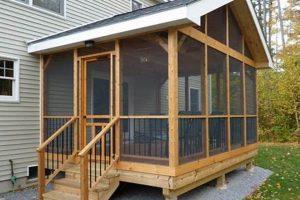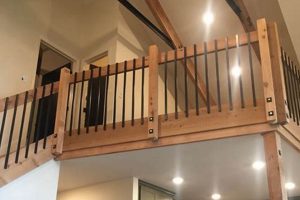The creation of affordable outdoor living spaces through self-executed hardscaping projects constitutes a significant trend in home improvement. This approach centers on utilizing cost-effective materials and personal labor to construct paved areas for relaxation, entertainment, or aesthetic enhancement of residential properties. For example, homeowners might opt for poured concrete slabs, repurposed brick, or gravel pathways as alternatives to professionally installed stone or manufactured paver systems, significantly reducing project expenses.
Such projects offer homeowners considerable cost savings and the opportunity to personalize their outdoor environment to align with specific design preferences and functional requirements. Historically, similar approaches have been employed across various cultures and economic strata to create usable outdoor spaces. Modern iterations, however, leverage readily available materials and online resources, empowering individuals with limited budgets to achieve professional-looking results. The inherent benefits include increased property value, enhanced outdoor enjoyment, and a tangible sense of accomplishment for the homeowner.
The subsequent sections will detail various strategies for achieving such outcomes, focusing on material selection, design considerations, and construction techniques that prioritize affordability and ease of implementation. These include methods for utilizing recycled materials, creating simple paver patterns, and employing efficient installation processes.
Strategies for Economical Patio Paving Projects
The following recommendations aim to guide individuals toward achieving cost-effective paved patio spaces through careful planning and resource utilization.
Tip 1: Material Acquisition from Salvaged Sources: Sourcing pavers from demolition sites, construction surplus yards, or online marketplaces often yields substantial savings. Brick, concrete blocks, and flagstone are frequently available at reduced prices or can be obtained for free.
Tip 2: Concrete Slab Alternatives: Instead of traditional pavers, consider pouring concrete slabs directly. This approach is often more cost-effective than purchasing individual pavers and allows for customized shapes and sizes. Staining or stamping the concrete can enhance its aesthetic appeal.
Tip 3: Gravel and Crushed Stone Pathways: Opting for gravel or crushed stone as the primary paving material provides a permeable and inexpensive alternative to solid pavers. Proper base preparation, including a compacted sub-base and weed barrier, is crucial for stability and longevity.
Tip 4: Simple Pattern Design: Complex paver patterns require more cuts and specialized tools, increasing both material waste and labor. Opt for a straightforward pattern, such as a running bond or herringbone, to minimize complexity and reduce costs.
Tip 5: Utilizing Pallet Wood: Disassembled wooden pallets can be repurposed as decking or pathway materials. Proper sanding, sealing, and weatherproofing are essential to prevent decay and ensure structural integrity.
Tip 6: Modular Paver Systems: Investigate modular paver systems that interlock without mortar. These systems simplify installation, reduce material costs associated with mortar or adhesive, and offer flexibility for future adjustments or repairs.
Tip 7: Incorporating Landscape Elements: Integrate landscape elements such as planting beds, decorative grasses, or stepping stones to reduce the overall paved area, thereby lowering material expenses.
These strategies collectively offer practical approaches to minimizing expenses while creating functional and aesthetically pleasing outdoor paved areas. Success depends on meticulous planning, careful material selection, and diligent execution.
The subsequent discourse will focus on the long-term maintenance considerations to ensure the durability and longevity of these economical patio paving solutions.
1. Material Sourcing
Material sourcing constitutes a cornerstone of successful and economical patio paving projects. The type, quantity, and cost of materials directly influence the overall expense and aesthetic outcome of the patio. Procurement strategies that prioritize cost-effectiveness are thus essential for individuals pursuing do-it-yourself patio construction on a budget. Failure to secure affordable materials negates the potential for savings inherent in self-executed projects, thereby undermining the foundational premise of accessible patio design. For example, choosing locally sourced gravel instead of imported stone significantly reduces transportation costs and overall project expenditure. Similarly, acquiring reclaimed brick from demolition sites, instead of purchasing new pavers, can dramatically lower material expenses.
The relationship between material sourcing and project affordability extends beyond initial cost. The choice of material also dictates long-term maintenance requirements and potential replacement expenses. Durable materials, even if initially more costly, can prove more economical in the long run due to their extended lifespan and reduced need for repairs. Conversely, less expensive but less durable options may require more frequent replacement, ultimately increasing the total cost of ownership. Consider the selection of pressure-treated lumber for patio framing versus untreated lumber; while the former carries a higher upfront cost, its resistance to rot and insect infestation can prevent costly structural repairs later. Another instance involves the utilization of recycled concrete aggregate, often available at a fraction of the cost of virgin aggregate, providing a sustainable and budget-friendly base layer for paver installation.
In conclusion, the strategic sourcing of materials is paramount for the successful execution of budget-conscious patio projects. By prioritizing cost-effective options, such as reclaimed materials, locally sourced aggregates, and durable yet affordable alternatives, homeowners can realize significant savings while creating functional and aesthetically pleasing outdoor spaces. A thorough understanding of material properties, lifecycle costs, and potential sourcing avenues is crucial for optimizing project outcomes and achieving the desired balance between affordability and long-term value. Overlooking this crucial step will compromise the project’s economics.
2. Base Preparation
Adequate base preparation is a non-negotiable aspect of any patio paving project, irrespective of budget. Its significance is magnified in do-it-yourself installations, where the absence of professional expertise necessitates meticulous adherence to established construction principles. Proper base preparation ensures the longevity, stability, and aesthetic appeal of the paved surface, directly impacting the project’s overall success and value.
- Excavation and Grading
Excavation involves removing existing topsoil and vegetation to create a level surface for the patio base. Grading ensures proper drainage, preventing water accumulation and potential structural damage. Inexpensive DIY patio projects often skip proper grading, leading to uneven settling, water pooling, and premature paver failure. For example, failing to excavate deep enough to accommodate the base materials may result in a patio that is level with the surrounding ground, increasing the likelihood of water intrusion. Ignoring this initial step can lead to significant expenses for repairs in the future.
- Sub-base Compaction
The sub-base, typically composed of compacted gravel or crushed stone, provides a stable foundation for the paver base. Proper compaction is critical to prevent settling and shifting of the pavers over time. A hand tamper or rented plate compactor can be used to achieve adequate compaction. Failing to compact the sub-base adequately can cause pavers to sink or become misaligned, compromising the patio’s appearance and structural integrity. For instance, neglecting to compact the sub-base beneath a walkway made of repurposed brick can result in the bricks becoming uneven and creating tripping hazards.
- Base Layer Material Selection
The base layer, usually composed of sand or fine gravel, provides a level setting bed for the pavers. The choice of material affects drainage and stability. Using the wrong material, such as topsoil, can lead to settling and heaving. Selecting a material that is too fine, like clay, may impede drainage and cause the pavers to become unstable. For instance, using builder’s sand instead of polymeric sand between pavers can lead to weed growth and displacement of the pavers, increasing maintenance needs and detracting from the patio’s appearance.
- Leveling and Screeding
Achieving a perfectly level base layer is crucial for ensuring a smooth and even paver surface. Leveling is typically accomplished using a screed board, which is dragged across the base material to create a uniform thickness. Ignoring this step can result in an uneven patio surface, making it difficult to place furniture and potentially creating safety hazards. For example, an improperly leveled patio constructed with salvaged concrete slabs could lead to uneven surfaces and tripping hazards, particularly for individuals with mobility challenges.
These four facets, from initial excavation to precise leveling, represent essential components of proper base preparation. While the allure of “diy cheap patio paver ideas” often tempts individuals to cut corners, neglecting these fundamental steps invariably leads to compromised results and increased long-term costs. Prioritizing meticulous base preparation ensures a stable, durable, and aesthetically pleasing patio, regardless of the materials used or the budget constraints.
3. Pattern Simplicity
The selection of a simple paving pattern directly correlates with the successful and economical execution of a do-it-yourself patio project. Complex patterns necessitate intricate cuts, specialized tools, and a higher degree of material waste, invariably increasing project costs. Conversely, uncomplicated patterns minimize these factors, rendering the project more accessible to individuals with limited experience and resources. A straightforward running bond pattern, for instance, requires minimal cutting compared to a herringbone or basketweave design, thereby reducing material costs and installation time. The causal relationship is clear: increased pattern complexity equals increased project expense. Choosing a basic layout becomes a strategic decision for budget-conscious homeowners, directly influencing the feasibility of the undertaking.
The impact of pattern simplicity extends beyond mere material cost. Simplified patterns inherently reduce the learning curve for novice installers. Fewer cuts translate to less reliance on specialized tools, such as wet saws, and minimize the risk of errors that result in wasted materials and increased labor. Consider a homeowner attempting to replicate an intricate mosaic pattern with reclaimed brick. The time and effort required to precisely cut each brick to fit the pattern would be significantly greater than if the same homeowner opted for a basic grid pattern using whole bricks. Furthermore, the increased potential for errors in complex patterns translates to a higher likelihood of project delays and frustration, potentially leading to abandonment of the project altogether. Thus, pattern simplicity acts as an enabling factor, empowering individuals to confidently undertake and complete their patio paving projects without undue stress or financial strain. Another example is the use of stepping stones set in gravel. This simple pattern requires virtually no cutting and minimizes the amount of paving material needed.
In conclusion, pattern simplicity is a cornerstone of achieving economical and successful do-it-yourself patio projects. By minimizing material waste, reducing the need for specialized tools, and lowering the skill requirements for installation, simple patterns empower homeowners to create functional and aesthetically pleasing outdoor spaces on a budget. While complex designs may offer visual appeal, the increased costs and technical challenges associated with their execution make them less suitable for individuals pursuing cost-effective solutions. Opting for a simple pattern not only lowers the initial investment but also reduces the risk of project delays and complications, ultimately increasing the likelihood of a positive outcome.
4. DIY Installation
Self-installation represents a pivotal element in the realization of affordable patio paving projects. The elimination of professional labor costs constitutes a significant source of potential savings, making do-it-yourself execution a central tenet of economical patio design.
- Labor Cost Reduction
Engaging professional contractors for patio installation incurs substantial labor expenses. These costs often comprise a significant portion of the overall project budget. By undertaking the installation personally, homeowners directly eliminate these expenses, channeling those funds towards material acquisition or other project enhancements. For example, a patio installation that would cost $5,000 with professional labor might be achievable for $2,000 solely in material costs through DIY implementation.
- Control Over Project Timeline
DIY installation grants homeowners complete control over the project timeline. Dependence on contractor availability and scheduling conflicts is circumvented, allowing for flexible project execution at the homeowner’s own pace. This control is particularly beneficial for projects with limited time constraints or those that need to be integrated with other home improvement activities. Conversely, reliance on external contractors can lead to delays and scheduling inefficiencies, increasing overall project duration.
- Enhanced Personalization and Customization
Self-installation empowers homeowners to tailor the patio design and construction to their precise specifications. The ability to make real-time adjustments and incorporate personalized features is enhanced, resulting in a patio that aligns perfectly with ind
ividual aesthetic preferences and functional requirements. Professional installations, while often efficient, may lack the nuanced customization that can be achieved through personal execution. Changes and adaptation can be done as needed. - Skill Development and Empowerment
Undertaking a DIY patio installation provides homeowners with valuable hands-on experience and fosters skill development in construction and hardscaping techniques. This newfound expertise can be applied to future home improvement projects, creating a cycle of self-reliance and cost savings. The satisfaction of completing a significant home improvement project personally also contributes to a sense of accomplishment and empowerment, further enhancing the overall value of the undertaking.
The multifaceted benefits of DIY installation, encompassing cost reduction, timeline control, personalization, and skill development, collectively underscore its critical role in the successful implementation of affordable patio projects. By embracing self-execution, homeowners not only minimize expenses but also gain greater control over the entire project lifecycle, resulting in a patio that is both economically viable and aesthetically tailored to their individual needs and preferences.
5. Recycled Materials
The utilization of recycled materials constitutes a significant strategy in the domain of economically viable do-it-yourself patio paving projects. The application of repurposed materials offers a dual benefit: reduction of project costs and promotion of environmentally sustainable construction practices. The subsequent details outline key aspects of this approach.
- Reclaimed Brick and Concrete
Reclaimed bricks and concrete elements from demolition sites or renovation projects represent a readily available and cost-effective source of paving materials. These materials, often available at significantly reduced prices compared to new pavers, offer a weathered aesthetic and contribute to the reduction of construction waste. For example, salvaged bricks from a demolished building can be cleaned and relaid to create a unique and characterful patio surface. This approach not only minimizes material costs but also reduces the environmental impact associated with the production of new paving materials.
- Crushed Concrete Aggregate
Crushed concrete aggregate, derived from recycled concrete, serves as an effective and economical base material for patio construction. This material provides excellent drainage and stability, comparable to traditional gravel or crushed stone bases, at a fraction of the cost. For instance, using recycled concrete aggregate as a sub-base layer beneath pavers or stepping stones creates a solid foundation, preventing settling and ensuring the longevity of the patio surface. The utilization of this material also diverts concrete waste from landfills, further promoting sustainable construction practices.
- Repurposed Pallet Wood
Wooden pallets, often discarded by businesses, can be disassembled and repurposed as decking or pathway materials within patio designs. While requiring more preparation and treatment compared to traditional pavers, pallet wood offers a rustic aesthetic and a significantly lower material cost. For example, sanded, sealed, and weather-treated pallet wood planks can be used to create a raised patio deck or a pathway through a gravel-filled patio area. Proper treatment is essential to prevent rot and insect infestation, ensuring the longevity of the wood. The recycling of pallets reduces wood waste and contributes to the conservation of forest resources.
- Recycled Rubber Pavers
Recycled rubber pavers, manufactured from recycled tires, offer a durable, slip-resistant, and environmentally friendly alternative to traditional concrete or stone pavers. These pavers are particularly well-suited for play areas, pool decks, or other areas where safety and comfort are paramount. For instance, recycled rubber pavers can be used to create a soft and resilient surface around a children’s play structure, reducing the risk of injuries. While potentially more expensive than some other recycled materials, the long-term durability and safety benefits of recycled rubber pavers can justify the initial investment. Their utilization also helps to reduce tire waste and promote the recycling of rubber products.
These strategies, representing varied applications of recycled materials, demonstrate the considerable potential for cost reduction and environmental stewardship within the context of do-it-yourself patio paving projects. Strategic incorporation of these materials allows for the creation of functional and aesthetically pleasing outdoor spaces while minimizing financial outlay and environmental impact.
6. Long-Term Maintenance
The long-term maintenance of do-it-yourself (DIY) patio paver installations, especially those constructed with cost-effective materials, is a critical determinant of their overall lifespan and economic viability. Initial cost savings can be quickly negated by premature degradation or failure if proper maintenance protocols are not implemented. Therefore, understanding the interplay between material selection, construction techniques, and ongoing maintenance practices is crucial for optimizing the investment in DIY patio projects.
- Weed and Vegetation Control
Inexpensive patio installations are often more susceptible to weed and vegetation intrusion due to less robust construction methods and potentially permeable materials. Regular removal of weeds and vegetation is necessary to prevent structural damage and maintain aesthetic appeal. For example, weeds growing between pavers can displace the material, leading to uneven surfaces and potential tripping hazards. Employing preventative measures, such as applying polymeric sand or installing weed barriers, can minimize weed growth. Neglecting weed control can result in significant repair costs and a shortened patio lifespan.
- Joint Stabilization and Refilling
The joints between pavers are vulnerable to erosion and displacement, particularly in DIY installations where precise fitting and sealing may be lacking. Regular inspection and refilling of joints with appropriate materials, such as sand or polymeric sand, are essential to maintain paver stability. For example, rainwater runoff or foot traffic can erode the jointing material, causing pavers to loosen and shift. Failure to address this issue can lead to instability and eventual patio failure. The cost of replenishing joint material is minimal compared to the expense of repairing or replacing the entire patio surface.
- Surface Cleaning and Sealing
The surfaces of cost-effective paving materials, such as reclaimed brick or poured concrete, may be more porous and susceptible to staining or weathering. Regular cleaning with appropriate cleaning agents is necessary to remove dirt, algae, and other contaminants. Sealing the patio surface can provide added protection against staining, weathering, and water damage. For instance, applying a sealant to a patio constructed with repurposed pallet wood can significantly extend its lifespan by protecting it from moisture and decay. Neglecting surface cleaning and sealing can result in a deteriorated appearance and a reduced li
fespan for the patio surface. Low power pressure washing can be utilized to prevent damage to materials. - Addressing Drainage Issues
Improper drainage can lead to water accumulation, which can damage the patio structure and create safety hazards. Regular inspection of drainage pathways and ensuring that water flows away from the patio surface is crucial. For example, blocked drains or improper grading can cause water to pool on the patio surface, leading to frost heave in colder climates or promoting the growth of mold and algae. Correcting drainage issues promptly can prevent costly repairs and maintain the safety and usability of the patio. DIY solutions for drainage can be deployed such as digging a shallow ditch and filling it with gravel.
These facets of long-term maintenance, encompassing weed control, joint stabilization, surface cleaning, and drainage management, collectively contribute to the sustained performance and economic value of DIY patio paver installations. While the initial appeal of “diy cheap patio paver ideas” lies in their affordability, consistent and proactive maintenance practices are essential to realizing their full potential and preventing costly repairs or premature replacements. A small investment in regular maintenance can yield significant returns in terms of extended patio lifespan and sustained aesthetic appeal.
Frequently Asked Questions Regarding Economical Patio Paving Strategies
This section addresses common inquiries and misconceptions associated with affordable do-it-yourself patio paver projects, providing clarity on crucial aspects of planning, construction, and maintenance.
Question 1: Can truly durable patios be constructed with inexpensive materials?
Durability is contingent upon a combination of material properties, construction techniques, and maintenance practices. While premium materials often offer inherent advantages, properly installed and maintained inexpensive alternatives, such as reclaimed brick or crushed gravel, can provide satisfactory longevity. Attention to base preparation, drainage, and ongoing maintenance is paramount.
Question 2: Is specialized equipment necessary for cost-effective patio paving projects?
While certain tools, such as a plate compactor or wet saw, can enhance efficiency and precision, many projects can be completed with basic hand tools. Careful planning and material selection can minimize the need for specialized equipment. For instance, choosing a simple paver pattern reduces the requirement for complex cuts that necessitate a wet saw.
Question 3: How can drainage issues be effectively addressed in DIY patio installations?
Proper grading during base preparation is crucial for ensuring adequate drainage. The patio surface should slope away from structures to prevent water accumulation. French drains or permeable paver systems can be incorporated to manage excess water. Regular inspection and maintenance of drainage pathways are essential to prevent blockages.
Question 4: What are the most common mistakes to avoid when building a low-cost patio?
Frequently encountered errors include inadequate base preparation, improper drainage, neglecting weed control, and using unsuitable materials. Cutting corners on essential steps to save initial costs often results in premature patio failure and increased long-term expenses.
Question 5: Is it realistic to construct a patio using only recycled materials?
Constructing a patio solely from recycled materials is feasible, although material availability and aesthetic preferences may influence the design. Reclaimed brick, crushed concrete, and repurposed pallet wood are viable options. However, careful inspection and preparation of recycled materials are necessary to ensure structural integrity and safety.
Question 6: How frequently should a low-cost patio be sealed or treated?
The frequency of sealing or treating a patio depends on the material type and environmental conditions. Porous materials, such as reclaimed brick or untreated wood, require more frequent sealing than dense materials like concrete. A general guideline is to reseal the patio every one to two years, or as needed based on visual inspection and material performance.
Effective implementation of economical patio paving strategies requires a comprehensive understanding of material properties, construction techniques, and maintenance practices. Addressing these frequently asked questions facilitates informed decision-making and minimizes the risk of project failures.
The subsequent discourse will focus on advanced design considerations for achieving aesthetically pleasing and cost-effective patio spaces.
Conclusion
The preceding exploration of “diy cheap patio paver ideas” underscores the feasibility of creating functional and aesthetically pleasing outdoor spaces without incurring excessive financial burdens. Successful implementation hinges upon strategic material sourcing, meticulous base preparation, simplified design patterns, diligent self-installation, resourceful utilization of recycled materials, and consistent long-term maintenance practices. Neglecting any of these critical elements increases the risk of project failure and diminishes the potential for achieving lasting value.
Ultimately, the decision to pursue a cost-effective, do-it-yourself patio project necessitates a commitment to thorough planning, careful execution, and proactive maintenance. While the allure of immediate savings is undeniable, the long-term success of such endeavors depends on a comprehensive understanding of the principles outlined herein. Thoughtful consideration of these factors empowers homeowners to transform their outdoor spaces into valuable assets while adhering to budgetary constraints, enhancing property value and personal enjoyment for years to come.







